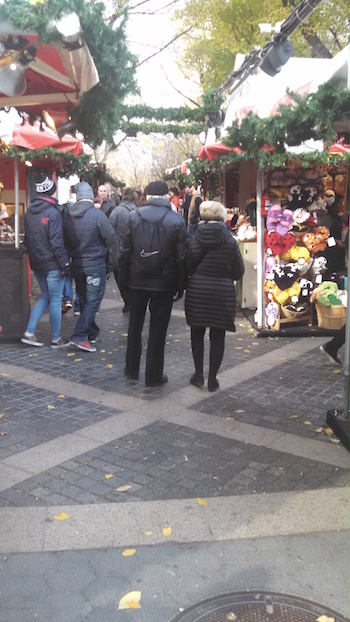
BY JOSH ROGERS | You might think it’s hard to hide Central Park’s 843 acres of green space, but the Columbus Circle Holiday Market seems to give it a try every Christmas season.
The market’s crowds and sprawling stalls consume the narrow entrances to the park. It’s easy to imagine a tourist trying to visit the park not realizing they can get to the public space at Columbus Circle.
The holiday market, which expanded by a third in 2012 according to DNAinfo, has more space to operate because the city bounced street art vendors out five years ago.
The city parks commissioner at the time, Adrian Benepe, said of the parks’ street vendors: “They can still vend their stuff, they just can’t do it in uncontrolled droves where park visitors are forced to walk through a gauntlet of vendors.”
Perhaps the “droves” hawking their wares in the holiday market are controlled, but clearly it is not an easy stroll into the park at Columbus Circle, one of the busiest entry points.
There are two real differences between the two types of vendors. The street vendors don’t pay the city and they don’t take up as much space as the Holiday Market.
“The [Columbus Circle] Holiday Market is 100 times bigger than the vendors were when they were there,” Robert Lederman, longtime leader of the street vendor group known as ARTIST — for Artists’ Response to Illegal State Tactics — said, exaggerating for effect. “The vendors even at their most aggressive and greedy never came close to taking up that much space.”
Urbanspace, which runs the city’s holiday markets, did not respond to requests for comment.
Doug Blonsky, president and CEO of the Central Park Conservancy, acknowledged the market can get a “little clogged” and said he would look into the matter.
A Parks Department spokesperson said the agency does monitor the market and makes sure the aisles have six feet of space for pedestrians and that park entrances have an eight-foot clearance to allow for emergency vehicles. But the large, fluctuating space taken up by holiday shoppers is obviously not measured.
The agency and conservancy each collected $538,000 from the Columbus Circle market last year, a figure that has grown steadily from $387,000 in 2011, according to the Parks Department.
Lederman’s group, meanwhile, which had previously earned a good record suing the city, lost a federal court case challenging the 2010 rules, and then the Supreme Court declined to take up their appeal. Lederman said he heard that Justice Elena Kagan, who grew up on the Upper West Side, was the only one who voted to hear arguments.



































